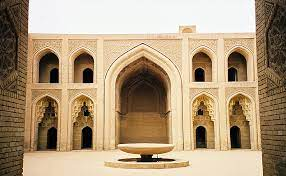Abbasid architecture developed in the Abbasid Caliphate between 750 and 945, primarily in its heartland of Mesopotamia. The Abbasids were influenced mainly by Mesopotamian architectural traditions and later influenced Persian as well as Central Asian styles. They evolved distinctive styles of their own, particularly in decoration of their buildings. While the Abbasids lost control of large parts of their empire after 870, their architecture continued to be copied by successor states in Iran, Egypt and North Africa.
Rajput Architecture represents different types of buildings, which may broadly be classed either as secular or religious. The secular buildings are of various scales. These include temples, forts, stepwells, gardens, and palaces. The forts were specially built for defense and military purposes due to the Islamic invasions . Rajput Architecture continued well into the 20th and 21st centuries, as the rulers of the princely states of British India commissioned vast palaces and other buildings, such as the Albert Hall Museum , Lalgarh Palace , and Umaid Bhawan Palace . These usually incorporated European styles as well, a practice which eventually led to the Indo-Saracenic style . The Hill Forts of Rajasthan ( Amer , Chittor , Gagron , Jaisalmer , Kumbhalgarh , Ranthambore ), a group of six forts built by various Rajput kingdoms and principalities during the medieval...


Comments
Post a Comment